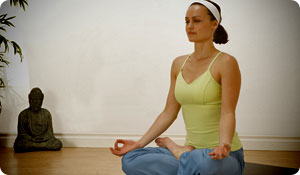
If you can't stand the heat, stay out of the studio. The hot yoga studio, that is. Hot yoga, also called Bikram yoga, can be dangerous for some people. It can also be a challenging, safe and exhilarating way to practice yoga. It all depends on the yogi and her body's unique ability to respond to intense heat.
What is hot yoga? While yoga devotees have practiced in hot climates for centuries, Bikram yoga specifically dials up the heat in the yoga studio to a steaming 105 degrees and 40 to 60 percent humidity. Bikram yoga is a brand name for a style of Hatha yoga made popular by Bikram Choudhury in the 1970s. The unchanging sequence of 26 postures is practiced over a 90-minute session in a hot, humid room. The idea is that heat causes the body to flush out impurities through sweat, increases muscle and joint flexibility, and bumps up the athletic, aerobic and healing qualities of yoga. But is it dangerous?
Many people experience symptoms of heat exhaustion when they practice hot yoga. Even though Bikram Choudhury himself says that's normal and practitioners should tough it out, doctors and other sports authorities disagree. Working out in extreme temperatures can be very dangerous and Bikram yoga is an extremely athletic practice. Here's what some experts say about heat exhaustion:
Heat exhaustion is one of the heat-related syndromes, which range in severity from mild heat cramps to heat exhaustion to potentially life-threatening heatstroke.
Signs and symptoms of heat exhaustion often begin suddenly, sometimes after excessive exercise, heavy perspiration, and inadequate fluid or salt intake. Signs and symptoms resemble those of shock and may include:
- Feeling faint or dizzy
- Nausea
- Heavy sweating
- Rapid, weak heartbeat
- Low blood pressure
- Cool, moist, pale skin
- Low-grade fever
- Heat cramps
- Headache
- Fatigue
- Dark-colored urine
But what if you try hot yoga and love it? There are ways to make it safer.
- Make sure your doctor is okay with your hot yoga practice. Children, seniors, diabetics, pregnant women, people with cardiac conditions, a history of heat-related health conditions, and people taking certain medications should not try hot yoga.
- Start slowly. Get acclimated. If you're not used to hot weather, your body may react more strongly. Take it very easy during your first Bikram sessions. Don't hesitate to quit before the sequence is over, even if your instructor pushes you to stay.
- Drink lots and lots of water before, during, and after your yoga session.
- Wear skimpy clothing that allows sweat to leave your body.
- Keep a towel nearby to sop up the sweat and avoid slipping on your mat.
Most importantly, pay attention to what your body is telling you. If you feel faint, woozy, develop a headache or any other heat exhaustion symptoms, leave the hot studio and lie down on your back with your feet elevated until you feel better. If symptoms return, consider a less heated yoga practice. For some, Bikram yoga is just too hot to handle.
Resources:
Yoga Journal
Facing the Heat by Shari Waxman
http://www.yogajournal.com/practice/1186
Mayo Clinic
Heat Exhaustion, First Aid
http://www.mayoclinic.com/health/first-aid-heat-exhaustion/FA00020
Bikram Choudhury College of Yoga





